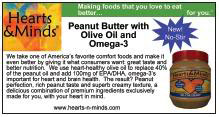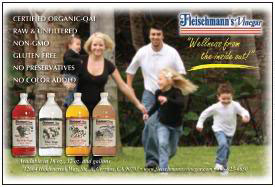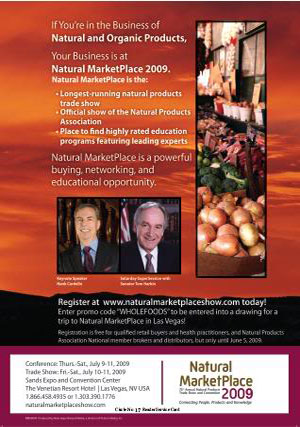Pills. Capsules. Powders. Tablets. Sigh. While these are great options for many consumers, others are looking to add a little spark to their dietary regimens. Fortunately, functional foods offer a great option for those who want to boost their diet with foods that are delicious and extra nutritious.
The functional foods category can be defined many ways, encompassing a large array of foods, beverages and products that have specific health benefits. Many foods may be considered functional for their intrinsic qualities and benefits, such as whole grains, but this article will instead focus on formulated functional products and ingredients. As Beth Naffziger, marketing manager for French Meadow Bakery, Minneapolis, MN, puts it, “Functional foods are enriched with nutrients that may not be inherent to a given food and may provide a health benefit beyond basic nutrition.”
According to a 2008 Natural Marketing Institute (NMI) presentation from SupplySide East 2008, the functional and fortified foods/beverage market is predicted to see 10% growth each year until 2012, when it will be a $64.4 billion sector (across all channels) (1).
Bob Green, president, Nutratech, Inc., West Caldwell, NJ, says, “The functional food/beverage industry is in its infancy. There’s no place to go but up.”
Plug Into the Latest Trends
The widespread appeal of functional foods may be because they fit well into consumers’ lifestyles. Says Stephanie Cundith, MS, RD, LD, nutrition spokesperson for the National Dairy Council, “Busy consumers today are looking for more from their foods. Their lifestyles demand more energy, better digestive health, bone health/strength, stronger immunity and general proactive daily health/wellness from easy, convenient foods that they already enjoy.”
Experts on functional foods agree that the top claims for functional foods, though not necessarily in order, are: weight management, digestion, beauty, energy and bone/joints. For more on bone and joints, see “Bottoms Up!” on page 34.
Weight Management. Statistics referenced by Green from the Weight Control Information Network indicate one-third of adults age 20 and older are overweight—that’s nearly 70 million adults. Approximately 50 million Americans go on a diet each year, yet only five percent keep off the weight they lose, partially due to improper dieting techniques and a lack of appropriate products (2). However, claims such as “lower-calorie” and “low-fat” are becoming less popular at this point, because results from these claims don’t feel tangible as quickly and customers give up on the product.
 Enter functional food products promoting satiety. Healthy weight loss is, of course, a long-term commitment to lifestyle and diet change, but if a customer feels full and satisfied after eating a certain functional product, they will continue to use it and probably feel better about their progress. Satiety claims are easier for customers to feel and to demonstrate clinically, and thus, customers will feel they are achieving small goals along their way to success.
Enter functional food products promoting satiety. Healthy weight loss is, of course, a long-term commitment to lifestyle and diet change, but if a customer feels full and satisfied after eating a certain functional product, they will continue to use it and probably feel better about their progress. Satiety claims are easier for customers to feel and to demonstrate clinically, and thus, customers will feel they are achieving small goals along their way to success.
Products with fiber and protein are examples of ingredients that help produce a sense of fullness. Using whole grains not only accomplishes this feat, but also supports heart health and healthy blood sugar—two conditions that also often affect those who are overweight. According to Naffziger, “Our number one functional food is our Hemp Bread, a whole-grain bread rich in fiber and protein made with the mighty hemp seed, which is a source of vitamins, minerals and essential amino and fatty acids.” French Meadow Bakery’s full line of functional bread also includes Daily Bread, which features Corowise, a [plant sterol] that naturally helps to reduce cholesterol. Naffziger describes the functional ingredient as “a meal in a slice of bread.”
Many consumers already eat a healthy diet and want their food to go the extra mile, to not only maintain health, but to encourage positive changes in their body chemistry. Green says, “Functional ingredients like Nutratech’s Advantra Z that stimulate thermogenesis, weight reduction, improve athletic performance, and appetite suppression, and build lean muscle will always get the most attention because they directly address these issues.” He also notes advantages for functional food products that include a proprietary branded ingredient that are scientific backing, safety and efficacy.
Energy. With Americans increasingly making the most out of every day and taking on a go-go-go attitude, energy products are certainly on the forefront of the afternoon slump battleground. Tom Hickey, director of marketing, DCI Cheese, Richfield, WI, says, “Energy is big—just look at the small shots available at check out across retail outlets.”
According to NMI’s report, two out of five consumers seek out healthy foods that provide them with the energy they need and over half of consumers would use food and beverages to prevent or treat their lack of energy (1).
Also, in response to an epidemic of sleep loss nationwide, energy products fall into a “need-results-now” sector of the functional foods market. Consumers want to pop open a functional beverage or energy bar and say, “WOW, I feel better, let’s go!” And they’ll want to keep going, too.
Caffeine and sugar have always been standbys for a quick boost, but can wreak havoc on our nerves and blood sugar levels. Colleen Zammer, director of VDF FutureCeuticals, Momence, IL, notes there is “a growing interest in non-caffeine energy, which we refer to as sustained energy. This is simply avoiding the spike and drop that you get from the former by consuming slow-burning complex carbs, fiber and protein, or what some would simply call balanced nutrition."
 Gastrointestinal/Digestive. Digestive problems are extremely common in the United States due to stress, poor diet or inherited conditions. “These are problems that resonate with a large population—as many as 40% of American adults experience some type of gastrointestinal trouble—and several organizations have looked to address these and found solutions in probiotics,” says Armin Salmen, Ph.D., vice president of research and development and quality assurance for Next Foods/GoodBelly, Boulder, CO. “General improvements to overall digestive health, immunity and support of the following conditions have been most often associated with probiotics: general stomach upset, irritable bowel syndrome, traveler’s diarrhea, side effects associated with antibiotics, colds and flu, vaginal and urinary infections and eczema,” he continues.
Gastrointestinal/Digestive. Digestive problems are extremely common in the United States due to stress, poor diet or inherited conditions. “These are problems that resonate with a large population—as many as 40% of American adults experience some type of gastrointestinal trouble—and several organizations have looked to address these and found solutions in probiotics,” says Armin Salmen, Ph.D., vice president of research and development and quality assurance for Next Foods/GoodBelly, Boulder, CO. “General improvements to overall digestive health, immunity and support of the following conditions have been most often associated with probiotics: general stomach upset, irritable bowel syndrome, traveler’s diarrhea, side effects associated with antibiotics, colds and flu, vaginal and urinary infections and eczema,” he continues.
Innovative products incorporating probiotics have appeared and disappeared over the past few years. The most common application for these friendly flora has been yogurt, but companies have been attempting to launch new applications for quite some time. For example, DCI Cheese Company offers a line of probiotic cheeses including cheddar, colby, Monterey and pepper jack.
And, GoodBelly’s Probiotic Fruit Drinks offer 10 billion live and active cultures per serving and are available in a variety of crowd-pleasing flavors.
Prebiotics should also be considered an important functional ingredient. They are the “food” for prebiotics and support their functionality. Lakshmi Prakash, Ph.D., vice president of business development, Sabinsa Corporation, Piscataway, NJ, notes, “Symbiotic combinations of prebiotics and probiotics are popular for their multifunctionality. Sabinsa Corporation recently launched LactoWise, a blend of Lactospore, a room temperature stable, GRAS self-affirmed probiotic and [prebiotic] Fenumannan (soluble galactomannans from fenugreek seeds).”
Beauty. Beauty shots could be the next big thing. No, not painful Botox injections, but beverages and other functional foods that are packed with ingredients to help achieve beauty from the inside out. These products may take many weeks for results to surface. On the other hand, consumers are beginning to understand the impact of nutrition on beauty and might be more willing to invest in long-term nutrition for skin, nails and hair, rather than seeing a dermatologist or plastic surgeon.
Functional beauty products have already been noted as a trend overseas in places like Japan and some European countries. For instance, Nestle and L’Oreal have combined efforts in this market to launch the Inneov line of functional food supplements in France. Will the trend catch on in the United States?
There’s a good chance it will, according to Robert Barry, Ph.D., director of scientific affairs at Kaneka Nutrients, L.P., Pasadena, TX. “If new product launches in Japan, Europe and Mexico are any indication, cosmeceutical beverages are definitely the future attractions,” he says. “The trend seems to be to incorporate ingredients that enhance or replace levels of substances naturally found in our body, especially the skin, that tend to decrease with age or exposure.”
Garrett Lindemann, Ph.D., chief executive officer/chief science officer at Gourmetceuticals, Big Horn, WY, agrees: “We’ve seen an uptick in this trend through the interest of large food manufacturers and premium brands in our antioxidant PPL-240, which could support the body’s ability to scavenge free radicals that can lead to sun damage—one of the major causes of skin aging,” he says. The company showed off its ingredient at the May 2008 SupplySide East show in the form of a trail mix that provides protection from the sun within minutes.
Will consumers go for this delivery method over supplements or topicals? According the The Age of Naturals report from the Benchmarking Company, it may depend on the form. While 74% of the women surveyed said they’d try a functional food for beauty that can be eaten on the go, only 52% said they’d try a powdered cosmeceutical drink that had to be prepared at home (3).
|
Functional For Everyone The elderly generally are at higher risk for health problems including osteoarthritis, high blood pressure, diabetes, heart disease, and metabolism and weight problems. Emphasizing the importance of preventative healthcare and wellness measures, Bob Green of Nutratech, West Caldwell, NJ, says, “Experts tell us that while disease and disability increase with age, poor health is not an inevitable consequence of aging. There’s no doubt the United States is on the brink of a longevity revolution.” Says Rodger Jonas, director of national sales for PL Thomas, Morristown, NJ, regarding seniors, “This special group cannot metabolize certain ingredients and thus needs alternatives or modified forms to be effective.” PL Thomas offers products for bone health, cognitive health, mood, energy and digestive health that can be formulated for different applications, some of which would be more appropriate for the senior population. Certain nutrients may be easier for seniors to consume if they are contained in a beverage or softer food, rather than in a harder to swallow and digest pill or capsule. ccording to Bob Gonzalez, president of Hearts&Minds LLC, Naperville, IL, “Older people may be more willing to try new products that are healthier, whereas children may be more reluctant. This is one reason Hearts & Minds LLC is trying to make the foods that people (older and children) love to eat better for them.” Hearts & Minds No-Stir Peanut Butter with Olive Oil and Omega-3 uses heart-healthy olive oil to replace 40% of the peanut oil and add 100 mg of EPA/DHA, The idea of “hiding” valuable nutrients in foods is not a new trick, but novel ingredients and formulations make it that much easier. “We see consumers, specifically mothers, taking an intense interest in nutritionally supporting their child’s growth and development. To that end, we are seeing more products fortified with omega-3 fatty acids. Everyone knows that the best source for omega-3 fatty acids are cold water fish. But as most parents know fish are not high on children’s top ten list of foods to eat—they may not even make the top 100. We developed Popumz, an organic, whole-grain baked snack crisp as an alternative source to ensure a child increases their daily intake of omega-3,” says Terry Howell, vice president of product development of Dr. Sear’s, Irvine, CA. Foods that incorporate fruits and vegetables are also popular choices for parents, as well as products to enhance and protect young immune systems. “One way to do this is with pre- and probiotics, to populate their digestive system with positive bacteria that leave little room for any bad actors,” says Colleen Zammer, director of sales, VDF FutureCeuticals, Momence, IL. Exciting products like probiotic cheese may be a unique answer for parents with finicky kids who will only eat something familiar and what they consider “safe.” |
Lindemann also notes that shoppers of functional beauty food will only come back for more if there are data behind the ingredient. “In order to maintain a loyal customer, the consumer needs to experience a benefit from consumption of the product,” he explains, such as from clinical validation.
Packaging may also play a role. According to Barry, “Most of these products have been launched by traditional cosmetic companies who extend their brand images across topical applications, beverages and supplements. In some instances, combination packages have been marketed to completely tie the brands together. The message is clear: enhance beauty from the inside and out.”
Sparking a Science vs. Benefits Debate
Amongst the various claims, categories and products out there, consumers will always pay top dollar for one thing—feeling the benefit now! Sales of products for which benefits are seen quickly will undoubtedly sell. Consumers will often give up on a product if they don’t see results soon. Emphasizing the importance of results consumers can feel and see, Zammer says, “Consumers are fickle and need feedback when it comes to doing something good for themselves. It’s a kind of Pavlovian behavior where we need rewards for our actions, and the faster we can see or feel an effect, the more likely we are to continue those actions.”
This type of “healthy impatience” isn’t so healthy, though. It is important to see results, but retailers should be prepared to explain to customers that functional foods usually only become functional if used in a similar manner as supplements—as part of a committed long-term regimen. Focusing on immediate results may cause consumers to miss out on the benefits of certain functional ingredients such as essential fatty acids or superfruits that may take a bit longer to become evident.
Rather than blind themselves with deceivingly immediate benefits and media hype, consumers and especially retailers should focus on the science behind functional products before choosing one. “A functional product that is an everyday food item needs to develop impressive credentials with respect to efficacy claims, to set itself apart from the regular product brands,” says Prakash of Sabinsa. This is especially true when it comes to hot products such as superfruits and omega-3s, for which the media is overrun with information. Research about the benefits of superfruits such as açaí have contributed to the national craze of people adding this berry to their diets for anything from antioxidant support to skin health and weight control. Retailers should be prepared to face customers, separate fact from fiction, clarify any misinformation and explain the benefits of a particular product or functional ingredient based on scientific sources.
Superfruits are important functional ingredients, with loads of scientific data to back their immune-enhancing or anti-aging properties. Although consumers may have to wait a bit longer (strong immune systems=no news is good news) to see how super certain fruits really are, the wait has not deterred sales in that area. According to SPINS, Americans spent more than $108 million on açaí products in the 52 weeks ending Feb. 21, up from just over $62 million the year before.
Kirsten Van Sickle, director of marketing for Zola, San Francisco, CA says, “Açaí berry has more antioxidants than any other edible fruit on the planet, including 60% more antioxidants than pomegranates and 500% more than blueberries. Antioxidants are important as they help defend healthy cells, protect the body and support overall wellness by neutralizing free radicals. Free radicals are thought to be the biggest factor in aging and have been shown to contribute to at least 50 diseases including cancer and cardiovascular disease.” Products such as the Zola Açaí Juice and Smoothies incorporate açaí berry with other functional ingredients to support energy and immunity in a single beverage.
Similarly, products incorporating essential fatty acids are becoming more prevalent. Omega-3s have definitely become popular in the public eye and companies are developing innovative ways to include fish oils in foods. Here’s where science takes the spotlight. Many consumers sensitive to that all-too-familiar fish oil regurgitation are breathing a sigh of relief…but is it that simple? Effectively incorporating active and/or delicate ingredients like fish oil into foods is crucial for ensuring customers end up with functional foods that truly function. Thankfully, technology is continually being developed to reduce the risk that processing and/or time might damage key ingredients, leaving foods perfectly functional.
A Battery of Technologies
Microencapsulation is one example of this technology. Rodger Jonas, director of national sales for PL Thomas, Morristown, NJ says, “Microencapsulation allows vitamin C to be used in dairy products, but more importantly allows ingredients that cannot survive processing to now be utilized. The advent of nano-technology helps make ingredients water-soluble and more bioavailable. We now have water-soluble CoQ10, K2 and omega oils as a result. What we have also found with probiotics and botanical ingredients is that improved ingredient processing along with raw material sourcing has led to ingredients that can be added pre-processing and still be efficacious.” It can also mask objectionable tastes and odors, make vivid colors possible, and improve the disperson and the stability of active ingredients.
“In addition,” says Prakash, “innovations in extraction processes, lyophilization and processing have made it possible to retain the inherent biological activity of natural actives in formulations.”
Many functional ingredients have a very quick timeline for which they must be utilized to be effective. With regard to açaí berry and other sensitive fruits, Chris Cuvelier, founder and president of Zola, adds, “New aseptic processing, which uses a flash-heating process, has made it possible to retain more nutrients, use less energy than conventional sterilization techniques such as hot-fill, and provide a product to be shelf stable without having to add preservatives.”
Zammer believes it may actually be the level of testing that suppliers and manufacturers alike are able to conduct with functional ingredients today that provides the supporting data needed to make food companies more comfortable to launch these products and make some kind of benefit statement (“claim”) on them, such as bioavailablity and bioactivity (Zammer notes that VDF Futureceuticals offers TargeTest to assist manufacturers in testing for these factors in functional foods).
The functional foods industry still continually faces obstacles when attempting to create innovative and effective  products and ingredients. Jonas says the key challenges for new functional ingredients are:
products and ingredients. Jonas says the key challenges for new functional ingredients are:
• Does it work?
• Will it function in my product?
• Will it survive processing?
• Will it still be active during distribution?
• How much do I need to use to be efficacious?
• What functional statements can I make?
On that note, Green of Nutratech says the biggest challenge facing the functional foods sector isn’t actually formulation or marketing—it’s the regulatory environment. He says, “Functional foods/beverages are essentially food-dietary hybrids, so from a regulatory perspective, several issues have been raised as to how to properly market and sell these products—and under what set of regulations they will be governed.” The market thus far has grown very quickly and regulation has yet to catch up with the market.
Rearrange Your Marketing Circuit
Consumers will certainly come to a natural store armed to the teeth with information they have gathered from Internet sources, friends and their neighbor’s second cousin—but too often with misinformation about functional products. Van Sickle says, “A marketing challenge that Zola faces specifically is the misconception that açaí or any other superfruit is a cure-all, despite what consumers may hear or read on the Internet.”
Increased home research on the Internet has undoubtedly been triggered by the biggest trend driving growth in functional foods and beverages today—self-healthcare—no doubt as a response to the current economic climate, says Green. Consumers want to stretch their healthcare dollar as far as it will go and have become more conscious of their spending.
However, says Terry Howell, vice president of product development, Dr. Sear’s, Irvine, CA, “Functional ingredients in most cases bring with them an added cost. As a marketer or manufacturer we need to be concerned that the benefits provided by the functional ingredient far outweigh the additional costs. It is extremely important for raw material suppliers and our industry as a whole to do a great job communicating a functional ingredients benefit.”
Retailers can also help clarify this dichotomy by educating staff and customers about the functional products on their shelves and even installing shelf-talkers to explain some of the information. Hickey believes that online can actually be an asset: “Blogs and the internet are other vehicles to integrate into product positioning and are excellent tactical tools to share information and health benefits.” Retailers can post information on their store’s Web site as a way to share health information with customers, encourage customer loyalty and increase the credibility of your store’s health knowledge. However, make sure all information posted on blogs or Web sites is carefully researched and cited to avoid any confusion or improper use of health claims from a regulatory standpoint. WF
References
- 1. “Pathway to Functional Foods” NMI presentation at SupplySide East 2008.
- 2. www.ext.colostate.edu/pubs/foodnut/09363.html
- 3. “The Age of Naturals.” Report from the Benchmarking Company. www.benchmarkingco.com
- 4. www.ific.org/nutrition/functional/index.cfm
Published in WholeFoods Magazine, June 2009









